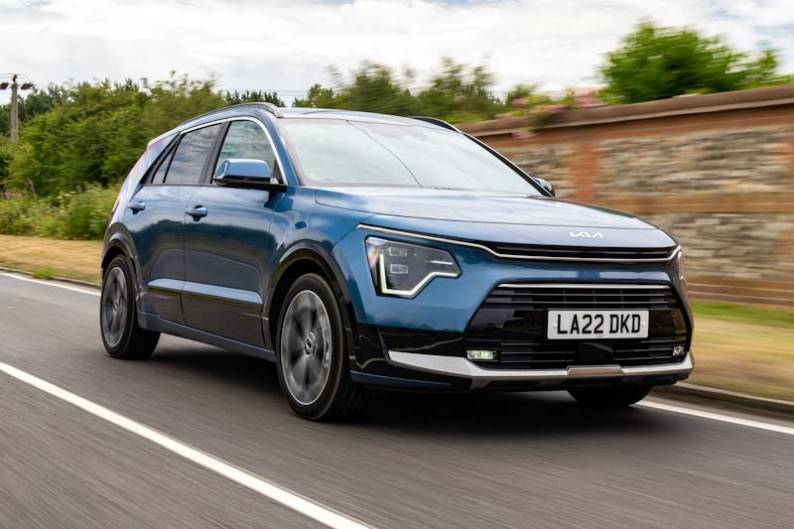
RAC sale – up to 33% off*
• Roadside cover from £5.29 a month†
• We get to most breakdowns in 60 mins or less
• Our patrols fix 4/5 breakdowns on the spot

Kia's second generation Niro Plug-in Hybrid is quite a complete package in second generation form. Jonathan Crouch drives it.
Ten Second Review
You may well know the Kia Niro as a Hybrid and if so, you're probably also aware that it can be a full-EV too. You may not though, know that you can additionally have it in a form in which it could be argued you get the best of both worlds. That's the Plug-in Hybrid variant we look at here.
Background
If you're set on electrification for your next family hatchback or small SUV, it's hard to make the right decision on which approach is best. If you've (rightly) rejected mild hybrid powerplants as being more hype than substance, that leaves you with full-Hybrid, Plug-in Hybrid or full-EV options. And trying different cars with these different approaches might understandably merely leave you somewhat confused. It'd be a lot easier wouldn't it, if the same design from the same brand offered all three options and you could try them back to back, un-influenced by other factors. The Kia Niro allows you to do just that.
We're now in this model second generation and in this form, it's a good deal more sassy than the somewhat conservative original. Currently, most Niro customers go straight for either the Hybrid or the EV versions, without looking properly at the PHEV model we're considering here. Is that a mistake? Let's see.
Driving Experience
We had hoped that this second generation Niro Plug-in Hybrid model's significant increase in battery size (from 8.9kWh to 11.1kWh) might have brought a greater increase in EV driving range. In the event, it's risen to around 40 miles with this second generation model (up from around 36 miles with the last versions of its predecessor). As before, you get a more powerful electric motor than the one in the ordinary Niro Hybrid - it's 83bhp in this PHEV. But the familiar 1.6 GDI normally aspirated petrol engine it works with is much the same and in this form puts out 180bhp via a 6-speed dual clutch automatic gearbox to the front wheels. Take off is smooth and if you flex your right foot enough to try and match the quoted 0-62mph time of 9.6 seconds, the petrol engine will kick in quite quickly with a noticeable thrum.
Best to relax the throttle a bit and go with the flow: it's certainly not worth regularly using the provided 'Sport' mode, which brings heavier steering and wakes the petrol engine up a bit earlier. The 'Sport' setting also changes the functionality of the steering wheel-mounted paddle shifters, which aren't fitted with base '2'-spec trim. Where included, the paddles are usually used to allow you to switch brake regeneration modes. In 'Sport', they become gearshift paddles.
In town when you're merely using the e-motor, this Niro feels pleasantly smooth and refined and the electric motor masks some of the delay when the 6-speed DCT gearbox is required to kick down. If you're a tower and need some element of proper EV motoring, this PHEV Niro variant makes far more sense than the EV version because towing capacity rises from 750kg to 1,300kg.
Design and Build
At first glance, unless you spotted the badge-work, you'd probably mistake this Niro Plug-in Hybrid for the full-EV version - or possibly for the self charging Hybrid model if you failed to spot the extra charging flap. Subtlety, as ever with a PHEV, is the key note here.
But it isn't the key note of this second generation Niro model's styling, which is a good deal more extrovert than that of its rather dull-looking predecessor, particularly if you avoid this base-trimmed version and stretch instead to top '4'-spec, which gains a rather overt coloured blade covering the C-pillar. At 4,420mm long, 1,825mm wide and up to 1,570 high, the clean-sheet redesign of this MK2 Niro is formulated on Kia's third-generation 'K3' platform.
Inside, the dash you get depends a lot on how much you've spent. The base '2'-spec model makes do with Kia's more basic 4.2-inch supervision colour cluster instrument display and an older-tech 8-inch centre touchscreen. Further up the range, the car gains the smarter twin 10.25-inch displays this fascia was rather obviously better designed for.
There's a more old-fashioned gear stick than you get in other Niros but this Plug-in Hybrid does share with its stablemates this central touch-sensitive strip, which hosts either the climate controls or the infotainment system hotkeys, depending which of its two display settings you've chosen. All the right eco boxes are ticked too, thanks to a cabin headliner made from recycled wallpaper and faux-leather upholstery fashioned from a 'bio PU' material containing healing eucalyptus oil. As with the previous generation Niro, the seating position is a fraction higher than the norm and across the range, the seats are well upholstered and supportive for longer journeys. There's plenty of cabin storage space too.
Thanks to 20mm more wheelbase length with this MK2 model, there's now space in the rear for a couple of six footers. And you get more boot space; 348-litres in this PHEV, though that compares poorly to the 451-litres you get in the HEV Hybrid and the 495-litre capacity of the Niro EV.
Market and Model
Prices for the Niro Plug-in Hybrid now open at just over £33,500, which gets you the entry-level '2'-spec version. You'll need over £36,000 for mid-range '3'-spec and over £39,000 for the top-spec '4' version. These figures represent a premium of around £6,000 over a non-plug-in Niro Hybrid; but you're looking at a saving of around £3,000 over an equivalently-specced full-electric Niro EV.
Choose this Niro Plug-in Hybrid in base '2'-spec trim and you'll have noted from the list pricing we gave earlier that there's quite a saving to be made. Bear in mind though that if you do that, you'll do without the 18-inch alloy wheels and useful gearshift and brake regen paddles fitted further up the range.
As we mentioned in our 'Design' section, with this base '2'-spec, you'll also have to accept a considerably lower standard of media tech, with an 8-inch centre screen that can't be paired with the useful 'Kia Connect' app. Further up the line-up, the 'Kia Connect'-compatible 10.25-inch centre screen is standard and top '4'-spec trim pairs it with a more advanced digital instrument cluster display of the same size. Along with a 10-inch head-up display which projects vital driving information, including speed, ADAS data and navigation commands, directly onto the front windscreen.
Across the range, safety kit includes 'Forward Collision-Avoidance Assist', 'Lane Keep Assist' and 'Lane Follow Assist', Should you happen to hit something, a 'Multi-Collison Brake' set-up works after an impact, braking the car so that it's less likely to go on and hit something else. There's also a High Beam Assist' system to automatically dip your headlights at night.
Cost of Ownership
We gave you the battery range figure for this PHEV model in our 'Driving Experience' section - around 40 miles. More than enough for a driver to complete the average daily commute in the UK. Topping up the Niro PHEV's 11.1kWh lithium-ion polymer battery to full takes two hours 55 minutes using a 3.3kW garage wallbox. Insurance is group 23A - or 24A for top-spec '4' trim. The official (pie in the sky) combined consumption fuel figure is 353.1mpg and the CO2 reading is between 18 and 22g/km, the latter removing the need for initial VED road tax payments.
There's now some clever efficiency tech too. An 'Intelligent Green Zone' Drive Mode automates the use of electric power by taking location guidance from the navigation system, driving pattern learning or manual driver input. Built-up areas or roads nearby schools and hospitals are designated as Green Zones, and the vehicle automatically switches to electric-only driving to reduce the exhaust emissions to zero in these environments. The customer can also take control of Green Zones along the route by setting other areas in which they wish to reduce their vehicle's emissions, such as around their neighbourhood.
The Niro PHEV debuts Hyundai Motor Group's very first 5.5kWh high-volt Positive Temperature Coefficient (PTC) heater for Plug-in Hybrid models, extending the electric driving range in colder conditions. The self-regulated ceramic elements provide cabin heating to complement the vehicle's heating core and ensure a continuous flow of warm air.
Summary
You can see why this Plug-in Hybrid model takes such a small proportion of Niro sales. The ordinary self-charging Hybrid variant gives you strong economy without the faff of plugging in. And if you are going to plug in, why not go full zero emissions with the Niro EV? It's not quite as simple as that though. Spiralling fuel prices make filling up a self charging Niro Hybrid ever more expensive. And the disappointingly patchy current UK EV public charging infrastructure could deliver range anxiety whenever you venture further afield in a Niro EV.
Such are the reasons for the continuing popularity of PHEVs and amongst cars of this genre in this price bracket, the Niro Plug-in Hybrid certainly has appeal. Particularly in this second generation guise with its significantly larger battery. It's pricier than we'd hoped it would be - but unfortunately nearly all its competitors are too. At least there's a bit more 'want one' factor this time round. Un-plug and play? That concept might make a bit more sense with one of these.







